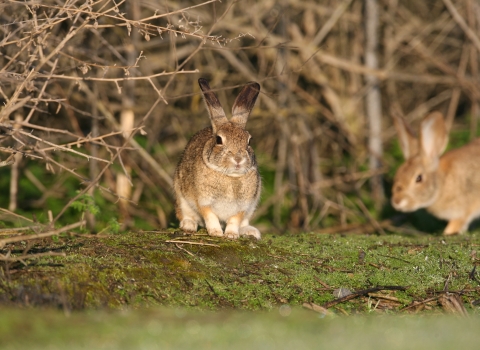January's record-breaking rainstorms left endangered riparian riparian
Definition of riparian habitat or riparian areas.
Learn more about riparian brush rabbits in a lurch when water poured over levees on the U.S. Fish and Wildlife Service’s San Joaquin River National Wildlife Refuge. Knowing the rabbits would be getting corralled into small islands of high ground by the floodwaters, Refuge staff jumped into action.
“Our biologists at the Refuge Complex quickly began trapping and rescuing riparian brush rabbits,” said Fumika Takahashi, wildlife biologist at the San Luis National Wildlife Refuge Complex, which includes the San Joaquin River National Wildlife Refuge. "We had to be very careful about preventing the spread of rabbit hemorrhagic disease, which is highly contagious to rabbits."
Rabbit hemorrhagic disease was detected on San Joaquin River National Wildlife Refuge in 2022 after two years of vaccination efforts by Refuge staff and partners in the riparian brush rabbit working group. Vaccinating the rabbits is one of the most important actions the Service and its partners can take to support the rabbit’s recovery.
For January's flood rescues, administering the life-saving vaccination immediately became a part of the plan.
“Our crew of biologists, along with the refuge manager and other staff, worked long and challenging hours,” said Takahashi. “We successfully rescued, vaccinated and tagged 103 rabbits and moved them to higher ground on the refuge.”
Preparing for Future Floods
While January's rain events were particularly severe, it was not the first time San Joaquin River has flooded the refuge.
“The last time the Refuge flooded was in 2017. It's definitely a growing concern with climate change climate change
Climate change includes both global warming driven by human-induced emissions of greenhouse gases and the resulting large-scale shifts in weather patterns. Though there have been previous periods of climatic change, since the mid-20th century humans have had an unprecedented impact on Earth's climate system and caused change on a global scale.
Learn more about climate change because we're seeing more long periods of drought followed by high rains and flash floods,” said Maggie Sepulveda, senior fish and wildlife biologist in Sacramento Fish and Wildlife Office's San Joaquin Valley Division.
In the past, when the San Joaquin River flooded, the rabbits were able to easily retreat to upland areas. With the modern levee system around the river, those paths to the uplands have been lost and the flooding is now more confined to where the rabbits live. The San Joaquin River National Wildlife Refuge is working to restore the river’s floodplains and provide more upland habitat for the rabbits to retreat to in times of flooding.
“Riparian brush rabbits are especially vulnerable to floods because they live at the edges of rivers,” said Eric Hopson, refuge manager at San Joaquin River National Wildlife Refuge. “They only live in a small area and there aren’t many of them, so events like this can have a big impact on their population and recovery.”
To help the subspecies survive future floods, the riparian brush rabbit working group is working to establish a satellite population of rabbits at San Luis National Wildlife Refuge, where the habitat is more flood resilient.
“There are several strategies we’re working on to help the riparian brush rabbit recover,” added Sepulveda. “The Service is working alongside so many passionate partners who are determined to protect the future of this species.”





